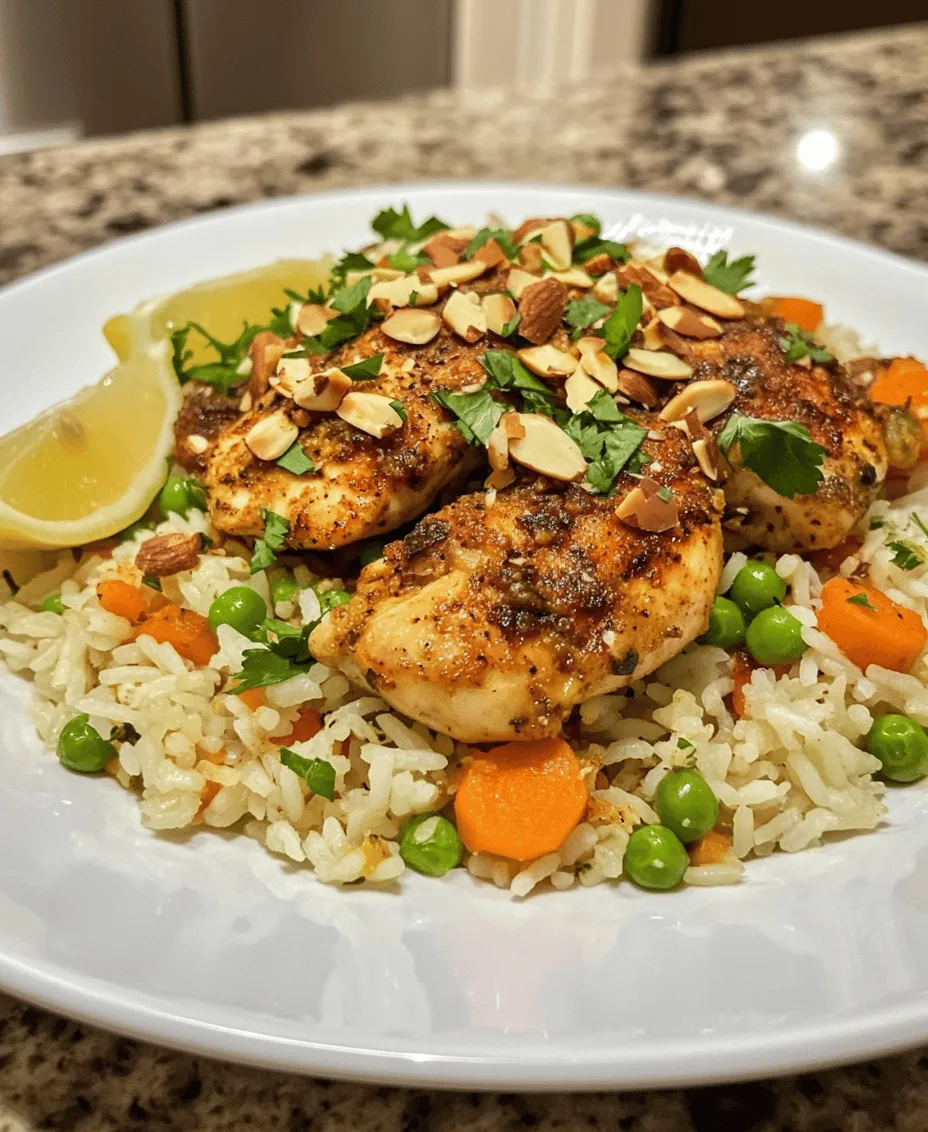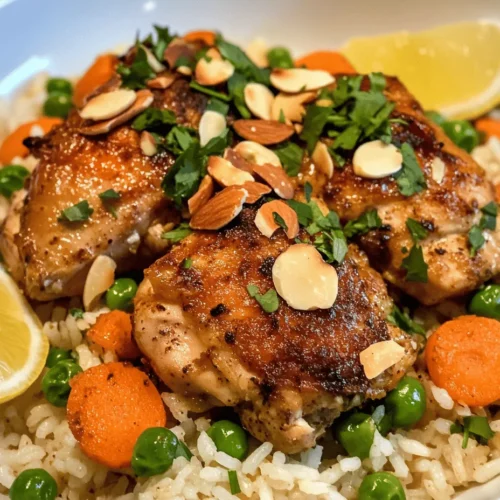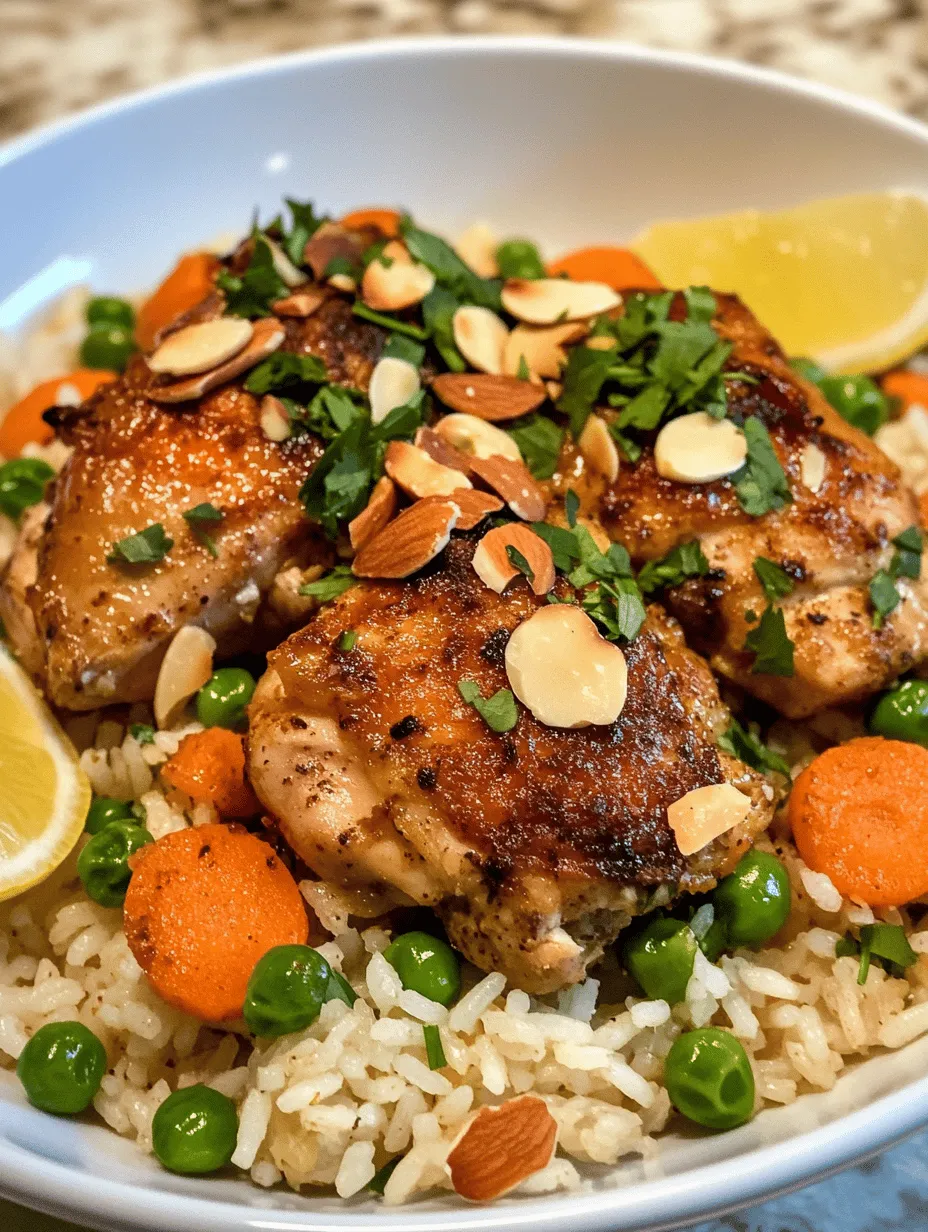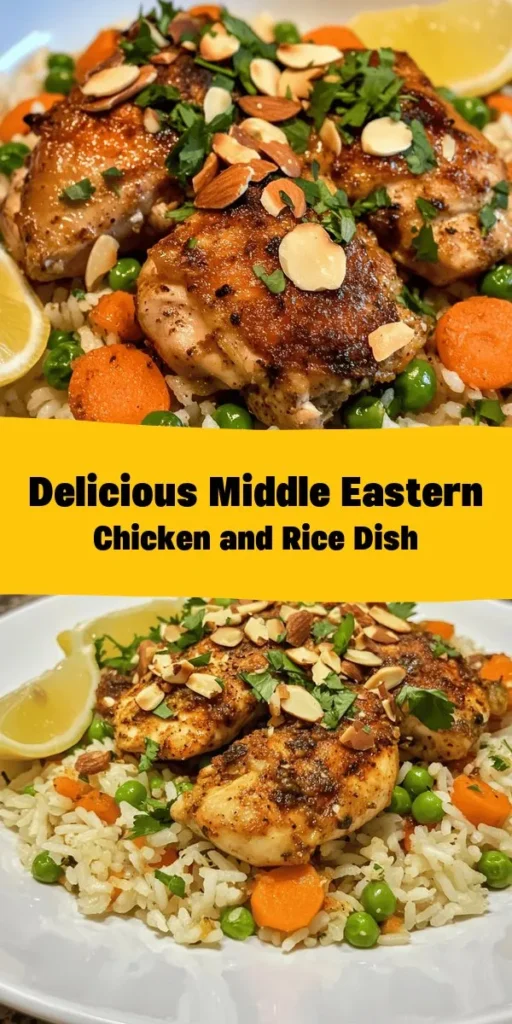Introduction
The Middle Eastern culinary tradition is a rich tapestry woven from centuries of diverse cultures, flavors, and techniques. With its origins rooted in ancient civilizations, this vibrant cuisine has profoundly influenced global gastronomy. From fragrant spices and fresh herbs to succulent meats and colorful grains, Middle Eastern dishes are as much about flavor as they are about storytelling. One such dish that beautifully embodies this heritage is the Middle Eastern Chicken and Rice Extravaganza.
This recipe is not just a meal; it’s an experience that brings together the warmth of family gatherings and the joy of shared feasts. The harmonious blend of spices, the tender chicken, and the fluffy basmati rice create a delightful balance of flavors and textures, making it an ideal choice for both casual family dinners and elegant entertaining. As you gather around the table, the aroma of this dish will transport you to the bustling markets and vibrant kitchens of the Middle East, where each bite tells a story of love, tradition, and community.
In this article, we will explore the ingredients that make this dish exceptional, the importance of marinating and sautéing, and the techniques that ensure your chicken and rice are cooked to perfection. Get ready to embark on a culinary journey that will elevate your cooking and impress your guests.
Understanding the Ingredients
A great dish starts with high-quality ingredients, and the Middle Eastern Chicken and Rice Extravaganza is no exception. Each component plays a vital role in creating the rich, layered flavors that define this meal. Let’s take a closer look at the main ingredients that come together to make this dish a standout.
Chicken Thighs
When it comes to poultry, chicken thighs are the star of this recipe. Opting for bone-in and skin-on thighs is crucial for maximizing flavor and moisture. The bones add depth to the broth while the skin crisps up beautifully during cooking, providing a delicious texture contrast. Chicken thighs are also more forgiving than breasts, remaining juicy even if slightly overcooked, making them a perfect choice for this dish.
Basmati Rice
The type of rice used significantly affects the final outcome of the dish, and basmati rice is the ideal choice for this Middle Eastern extravaganza. Known for its long grains and aromatic qualities, basmati rice cooks up fluffy and light, allowing it to absorb the flavors of the spices and chicken. Its unique fragrance and nutty flavor elevate the dish, making it an essential ingredient.
Vegetables
A medley of vegetables enhances both the flavor and nutrition of the dish. Onions and garlic form the aromatic base, infusing the dish with savory notes. Carrots add a touch of sweetness and a vibrant color, while peas contribute a pop of freshness. Together, these vegetables not only add depth to the overall flavor profile but also increase the nutritional value, making this meal a wholesome choice.
Spices
No Middle Eastern dish is complete without a blend of spices that define its character. In this recipe, we use cumin, coriander, cinnamon, and turmeric, each bringing its unique contribution to the dish.
– Cumin: Earthy and warm, cumin is a staple in many Middle Eastern dishes. It adds a depth of flavor and is known for its health benefits, including digestive support.
– Coriander: With its bright and citrusy notes, coriander complements the richness of the chicken while also enhancing the overall flavor profile.
– Cinnamon: Often associated with sweet dishes, cinnamon also plays a vital role in savory Middle Eastern cooking. Its warm sweetness adds a subtle complexity, balancing the spices.
– Turmeric: Known for its vibrant color and anti-inflammatory properties, turmeric lends a golden hue to the rice, making the dish visually appealing.
Garnishes
To finish off the Middle Eastern Chicken and Rice Extravaganza, garnishes play an essential role in elevating the dish. Toasted nuts, such as almonds or pine nuts, add a delightful crunch, while fresh herbs like parsley or cilantro introduce a burst of freshness. A squeeze of lemon just before serving brightens the flavors, ensuring a well-rounded and satisfying meal.
Marinating the Chicken
Marinating chicken is a fundamental step in developing the dish’s rich flavors. This process allows the spices to penetrate the meat, ensuring every bite is packed with taste. Additionally, marinating helps to tenderize the chicken, making it juicy and flavorful.
Step-by-Step Guide to Marinating Chicken Thighs
1. Prepare the Marinade: In a bowl, combine olive oil, minced garlic, ground cumin, coriander, cinnamon, and turmeric, along with salt and pepper to taste. Mix well until you have a smooth paste.
2. Coat the Chicken: Place the chicken thighs in a large resealable plastic bag or a glass dish. Pour the marinade over the chicken, ensuring each piece is well-coated. Use your hands to massage the marinade into the meat for maximum flavor absorption.
3. Marinating Time: For optimal results, marinate the chicken for at least 30 minutes at room temperature or up to 24 hours in the refrigerator. If you’re short on time, a 30-minute marinade will still impart great flavor. However, for a deeper taste, overnight marination is ideal.
Sautéing the Vegetables
Sautéing the vegetables is a crucial step that builds the foundation of flavor for the Middle Eastern Chicken and Rice Extravaganza. This technique caramelizes the natural sugars in the vegetables, enhancing their sweetness and depth.
Achieving the Perfect Sautéed Onion and Garlic
1. Heat the Oil: In a large pot or Dutch oven, heat a couple of tablespoons of olive oil over medium heat.
2. Add Onions First: Once the oil is hot, add chopped onions and sauté until they become translucent and start to caramelize, about 5-7 minutes. This process releases their natural sweetness and forms a flavorful base for the dish.
3. Incorporate Garlic: After the onions are softened and golden, add minced garlic, stirring constantly for about a minute until fragrant. Be careful not to burn the garlic, as it can turn bitter.
Cooking Carrots to the Right Tenderness
4. Add Carrots: Next, add sliced carrots to the pot. Sauté them alongside the onions and garlic for about 3-4 minutes. The goal is to soften them slightly while still retaining some crunch, providing a delightful texture contrast in the final dish.
5. Incorporate Peas: Finally, stir in the peas, allowing them to heat through just before adding the marinated chicken. This will prevent them from becoming mushy during cooking.
Browning the Chicken
Browning the chicken is a vital step in building flavor for the Middle Eastern Chicken and Rice Extravaganza. This process not only enhances the taste but also improves the dish’s overall appearance.
The Significance of Browning for Flavor Development
1. Heat the Pot: After sautéing the vegetables, push them to the edges of the pot, creating space in the center. Increase the heat to medium-high.
2. Brown the Chicken: Carefully place the marinated chicken thighs in the pot, skin-side down. Allow them to sear without moving them for about 5-7 minutes until the skin is golden brown and crispy. This step develops a rich, savory flavor that will infuse the rice and vegetables.
3. Flip and Brown the Other Side: Once browned, flip the chicken thighs and sear the other side for an additional 5 minutes. This creates a delicious crust while sealing in the juices.
As you prepare to combine these elements, the aromatic symphony of spices, sautéed vegetables, and browned chicken will create an enticing dish that promises to be a highlight at any dining table. In the following sections, we will delve into the final steps of cooking the rice and bringing this Middle Eastern Chicken and Rice Extravaganza to life, but for now, savor the anticipation of what’s to come.

Detailed Instructions on How to Brown Chicken Thighs Correctly
Browning the chicken thighs is a critical step in achieving a rich and flavorful base for your Middle Eastern Chicken and Rice Extravaganza. To begin, ensure your chicken thighs are thoroughly dried with paper towels; this helps achieve a beautiful golden-brown crust. Season the chicken generously with salt and pepper on both sides.
In a large, heavy-bottomed pot or Dutch oven, heat a few tablespoons of olive oil over medium-high heat. Allow the oil to heat until it’s shimmering but not smoking. Carefully place the chicken thighs in the pot, skin side down, making sure not to overcrowd the pan. If necessary, work in batches to maintain enough space for even cooking.
Cook the chicken thighs undisturbed for about 6-7 minutes or until they are deeply golden brown. Avoid moving them around too much to allow a crust to form. Once the skin is crispy and golden, flip the thighs and cook for an additional 5-6 minutes on the other side. Transfer the browned chicken to a plate and set it aside while you prepare the rice.
Tips for Managing Space in the Pot to Ensure Even Cooking
Managing space in your pot is crucial for achieving even browning and cooking. If you find that your pot is too small, consider using a larger pot or browning the chicken in batches. This prevents the chicken from steaming and ensures that each piece develops that coveted golden crust.
Additionally, avoid overcrowding the pan when adding the chicken. Leave enough space between each thigh to allow steam to escape and promote browning. If you notice any moisture accumulating in the pot, reduce the heat slightly to prevent the chicken from boiling instead of browning.
Cooking the Rice
Once your chicken is browned and set aside, it’s time to incorporate the basmati rice into the dish. Basmati rice is a staple in Middle Eastern cuisine, known for its long grains and nutty flavor. Here’s how to prepare it perfectly.
The Process of Incorporating Basmati Rice into the Dish
After removing the chicken, reduce the heat to medium and add a little more olive oil to the pot if necessary. You should have enough flavorful drippings to sauté the rice. Add a finely chopped onion and a couple of minced garlic cloves to the pot, stirring for about 2-3 minutes until they become translucent and aromatic.
Next, add the rinsed basmati rice to the pot. This is a crucial step; toasting the rice in the hot oil (and with the onions and garlic) helps enhance its flavor and prevents it from becoming mushy during cooking. Stir the rice continuously for about 3-4 minutes until it turns opaque.
Importance of Toasting Rice in the Pot for Enhanced Flavor
Toasting the rice not only imparts a delightful nutty flavor but also helps to create a firmer texture once cooked. This step is often overlooked but is essential for ensuring that your rice is fluffy and distinct, rather than sticky or clumpy.
Step-by-Step Instructions on Adding Chicken Broth and Achieving the Perfect Simmer
Once the rice is toasted, it’s time to add the chicken broth. For every cup of basmati rice, you will typically need about 1.5 to 2 cups of broth, but this can vary based on your specific rice brand and desired texture. Pour in the broth and stir to combine. Add the previously browned chicken thighs back into the pot, along with any juices that have accumulated on the plate.
Increase the heat to bring the mixture to a gentle boil, then reduce it to a low simmer. This simmering process is essential for cooking the rice evenly. You want to cover the pot with a tight-fitting lid and let it cook without lifting the lid for about 15-20 minutes. During this time, the rice will absorb the broth and flavors from the chicken.
Explanation of How Long to Cook the Rice for Optimal Results
Cooking the rice for the right amount of time is crucial for achieving that perfect texture. Typically, basmati rice will take about 15-20 minutes to cook fully. After this time, turn off the heat but leave the pot covered to steam for an additional 5-10 minutes. This resting period allows the rice to finish cooking and the grains to firm up.
Incorporating Peas and Final Cooking Steps
As the rice finishes cooking, it’s time to incorporate the peas. Timing is important here; you don’t want to add them too early, as they can lose their vibrant color and crisp texture.
Timing for Adding Peas to Maintain Their Bright Color and Texture
About 5 minutes before the rice is done, carefully remove the lid and sprinkle a cup of frozen peas over the top of the rice. Replace the lid and allow the residual steam to heat the peas through. This will keep the peas bright green and tender while ensuring they don’t become overcooked.
Instructions for Fluffing the Rice and Ensuring Even Cooking
After the resting period, remove the lid and gently fluff the rice with a fork. This is the moment to check for seasoning; add salt or pepper if necessary. Fluffing helps to separate the grains and ensure even distribution of the chicken and peas throughout the dish.
Importance of Resting the Dish Before Serving for Improved Texture
Resting the dish before serving is vital. It allows the flavors to meld together and gives the rice a chance to absorb any remaining moisture, resulting in a fluffy, well-cooked dish. Allow the pot to sit covered for about 10 minutes before serving.
Serving Suggestions
Presenting your Middle Eastern Chicken and Rice Extravaganza beautifully can enhance the dining experience. Start by spooning the rice onto a large serving platter, placing the chicken thighs artfully atop the rice.
Visual Presentation Tips for Serving the Chicken and Rice
Consider garnishing the dish with fresh herbs such as chopped parsley or cilantro for a pop of color. You could also sprinkle toasted almonds or pine nuts for added texture and flavor. A drizzle of olive oil or a squeeze of lemon juice can add brightness to the dish.
Recommended Garnishes to Elevate the Dish’s Appearance and Flavor
Enhance the dish with garnishes like diced tomatoes, sliced green onions, or even a dollop of yogurt on the side. These additions can balance the richness of the chicken and rice while providing a refreshing contrast.
Ideas for Pairing the Dish with Sides or Beverages That Complement Its Flavors
Pair your Middle Eastern Chicken and Rice with a fresh salad, such as a tabbouleh or a simple cucumber and tomato salad dressed with lemon and olive oil. For beverages, consider serving it with a glass of mint tea or a refreshing yogurt-based drink, such as ayran, to complement the spices and flavors of the dish.
Cultural Significance of the Dish
The combination of chicken and rice is a cherished staple throughout the Middle East, often associated with family gatherings and celebrations. This dish embodies the essence of home-cooked meals, bringing together rich flavors and nourishing ingredients.
Exploration of the Role of Chicken and Rice in Middle Eastern Meals
In many Middle Eastern cultures, the preparation of chicken and rice is not merely about nourishment; it often symbolizes hospitality and togetherness. Sharing a dish like this during gatherings fosters connections and creates lasting memories, making it an integral part of communal life.
Discussion on Variations of This Dish Across Different Middle Eastern Countries
Variations of chicken and rice can be found across various Middle Eastern countries. For example, in Saudi Arabia, you might encounter a dish known as Kabsa, where spices like cardamom and cloves are used to flavor the rice. In Lebanon, you may find a similar dish flavored with saffron, lending a beautiful yellow hue to the rice.
Insights into How This Recipe Can Be Adapted for Dietary Preferences
This recipe is highly adaptable, making it suitable for various dietary preferences. For a gluten-free version, simply substitute the basmati rice with quinoa or a gluten-free grain. Vegetarians can replace the chicken with chickpeas or lentils, enhancing the dish’s protein content while retaining its heartiness.
Conclusion
The Middle Eastern Chicken and Rice Extravaganza is a flavorful and satisfying dish that showcases the rich culinary traditions of the region. By using fresh ingredients and traditional cooking methods, you can create a meal that is not only delicious but also steeped in cultural significance.
This recipe encourages you to explore the vibrant flavors of Middle Eastern cuisine while offering the flexibility to adapt it to your preferences. So gather your ingredients, follow the steps, and indulge in this delightful dish that promises to transport your taste buds on a culinary journey. Experience the warmth of home-cooked meals and the joy of sharing with loved ones—try this recipe today and savor the rich flavors of the Middle East for yourself!



